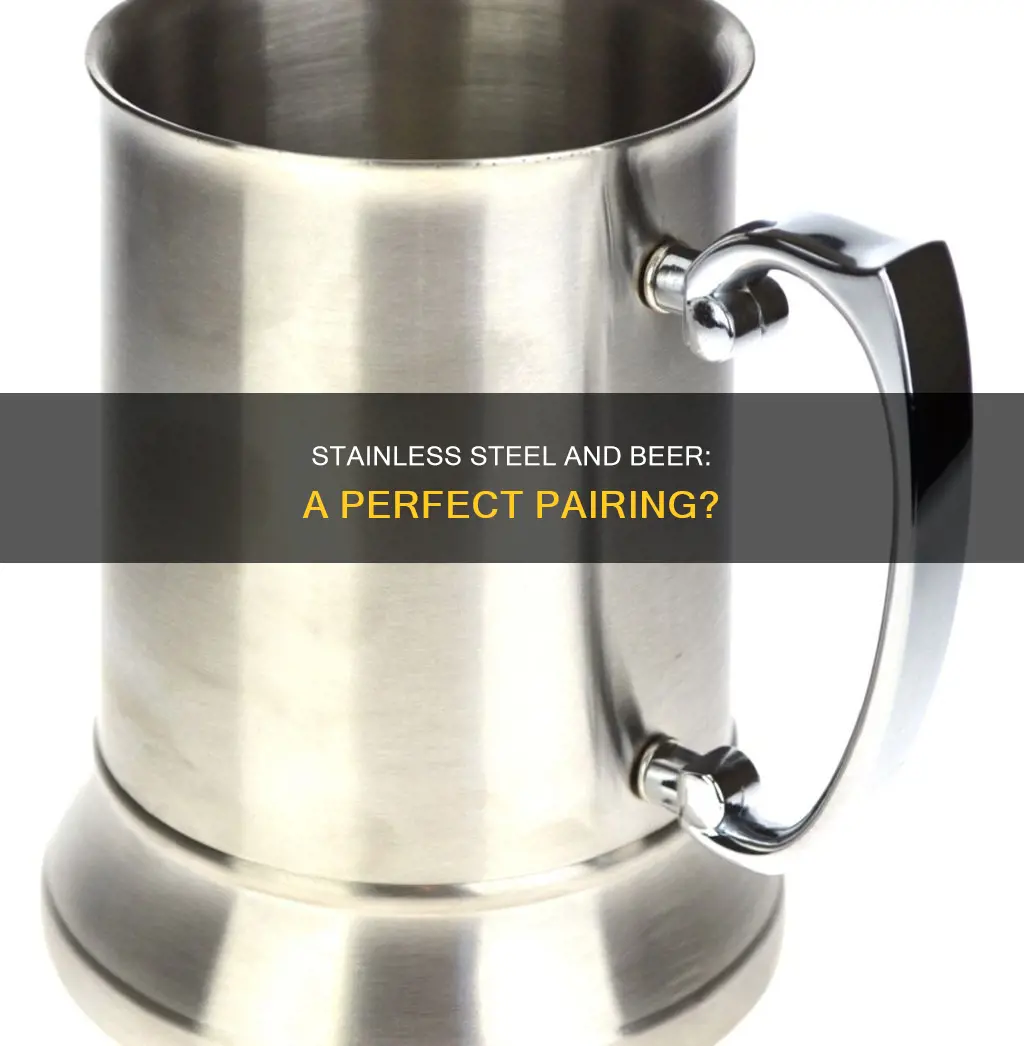
There is much debate about whether it is a good idea to drink beer from a stainless steel cup, mug, or tumbler. While stainless steel is safe to drink from, it may negatively impact the drinking experience. Beer is a unique beverage that affects almost all the senses, and the appearance of the drink is an important factor in how it tastes. Being able to see the colour and the foam on top of the beer greatly affects the drinking experience, and stainless steel mugs deny the drinker this opportunity. In addition, the smell of the stainless steel can clash with the beer's distinct smell, resulting in a 'metallic' taste. However, stainless steel is used in the brewing process, and beer is often stored in stainless steel kegs for long periods. Stainless steel is also better than glass for storing beer because it is unbreakable, insulates the beer, and does not allow sunlight to get into the container, preventing spoilage.
| Characteristics | Values |
|---|---|
| Safety | Drinking beer from stainless steel is entirely safe |
| Taste | Stainless steel does not affect the taste of beer |
| Sight | Stainless steel mugs deprive drinkers of seeing their beer |
| Smell | The smell of stainless steel can clash with the beer's distinct smell |
| Temperature | Stainless steel keeps beer cold for longer |
| Durability | Stainless steel is more durable than glass |
What You'll Learn

Stainless steel does not affect the taste of beer
There are a few reasons why stainless steel does not affect the taste of beer. Firstly, stainless steel is used in brewing beer. After mixing grains with water and yeast during beer production, the mixture is left in stainless steel beer kegs to ferment for about two weeks. If beer can be left untouched in a large stainless steel vessel for about two weeks, sipping beer from a stainless steel cup shouldn't be an issue.
Secondly, stainless steel does not react with acidic substances, so the chances of the metal dissolving into the alcohol and altering its flavour are slim. This is because stainless steel has a thin, transparent layer of chromium oxide that is inert and doesn't dissolve in water.
Thirdly, beer is often stored and transported in stainless steel containers, which are better than glass containers because they are more durable, insulate the beer, and do not let in sunlight, which can cause the beer to spoil.
Finally, while some people report a metallic" taste when drinking beer from stainless steel, this is not actually the taste of the steel itself. Our saliva cannot dissolve metal. What we perceive as a metallic taste and smell are the reactions between the metal and other chemical compounds present in our mouth and on our skin. This reaction can be avoided by cleaning and passivating the steel with vinegar or citric acid.
Drinking Beer on the Streets of Key West
You may want to see also

Stainless steel is used in the brewing process
Stainless steel is also easy to clean and sanitize. Its nonporous surfaces can be cleaned with ordinary detergents or mild soap solutions and a bit of elbow grease. The passivation layer on stainless steel is smooth enough that sanitization is simple and can be achieved with chemicals or steam. This saves time and money while ensuring proper sanitation practices throughout the brewing process.
Another advantage of stainless steel in brewing is its ability to resist galvanic corrosion. When two metals or a metal and a contaminant like dirt come into close contact with an electrolyte solution like beer, an electrical current flows through the solution, creating a chemical battery. Stainless steel has lower conductivity than other metals used in brewing, and its resistant coating resists oxidation, preventing galvanic corrosion.
Stainless steel is also favoured in brewing due to its cost-effectiveness. Compared to materials like copper or aluminium, stainless steel is a relatively low-cost option, especially when considering the cost across its entire service life.
Finally, stainless steel is versatile and can be used in various components of the brewing process, including kettles, mash tuns, fermenters, bright tanks, beer cooling systems, piping systems, valves, and fittings.
Is Root Beer Safe for Children to Drink?
You may want to see also

Beer glasses are more appealing than stainless steel
While it is entirely safe to drink beer from stainless steel, it is not the best option. Beer is a unique beverage that appeals to almost all the senses. The golden or dark hue with the majestic and velvety foam on top greatly affects the drinking experience. Serving beer in stainless steel mugs denies the drinker from this opportunity.
The stainless steel mug's grey outer surface blocks the view of the beer's colour, and the foam that will soon deflate. Beer glasses come in numerous shapes and sizes, each designed to complement a particular type of beer. In contrast, stainless steel mugs do not offer much in terms of shape, design, and appeal. Beer glasses are also the norm, as they have evolved from the traditional tankard, so it may be difficult to drink beer from a different vessel.
Stainless steel mugs can also affect the taste of the beer. When you raise the mug to drink, the metal's smell clashes with the beer's distinct aroma. As a result, some people experience a 'metallic' taste when drinking beer from a stainless steel mug. While stainless steel does not change the beer's taste, the clash of smells can confuse the senses.
Additionally, stainless steel mugs do not allow you to see the beer inside. Beer is a beverage that appeals to the sense of sight, and being able to see the colour and foam of the beer enhances the drinking experience. With a stainless steel mug, you are deprived of this visual appeal.
In conclusion, while stainless steel mugs can keep beer cold for longer, they fall short in terms of enhancing the overall drinking experience. Beer glasses are more appealing as they allow you to appreciate the colour, foam, and shape of the beer, engaging your sense of sight and enhancing the taste and smell of the beverage.
Beer and Coronavirus: What's Safe to Drink?
You may want to see also

Stainless steel growlers are better than glass
Stainless steel growlers are a popular accessory in the booming craft beer scene. These containers allow beer lovers to transport their favourite brew from place to place, maintaining the beer's temperature and taste. While glass growlers are also available, stainless steel offers several advantages.
Firstly, stainless steel growlers are significantly more durable than their glass counterparts. Glass is fragile and prone to breaking, which can lead to messy and disappointing spills. Stainless steel, on the other hand, is sturdy and resistant to shattering, providing peace of mind during transportation.
Another critical advantage of stainless steel growlers is their insulation properties. Stainless steel growlers are designed to keep your beer cold for extended periods. In contrast, glass growlers offer little insulation, and the beer inside will quickly warm up. Additionally, glass growlers often have smaller necks and less effective lids, potentially leading to CO2 escape and further temperature fluctuations.
The opacity of stainless steel growlers also plays a crucial role in preserving your beer's freshness. Glass growlers, especially clear ones, can allow sunlight to penetrate and cause "skunking," a term familiar to beer enthusiasts, which refers to beer spoilage due to excessive light exposure. Stainless steel, being opaque, blocks out all light, ensuring your beer stays fresh and flavourful.
While some may argue that seeing the colour and appearance of the beer is an essential part of the drinking experience, the benefits of stainless steel growlers outweigh this consideration. Maintaining the optimal temperature, avoiding spills, and preserving freshness take precedence over visual appeal for many beer aficionados.
In conclusion, stainless steel growlers offer superior durability, insulation, and protection from light exposure compared to glass alternatives. These advantages contribute to a more enjoyable and worry-free beer-drinking experience, making stainless steel growlers a preferred choice for craft beer enthusiasts.
A Beer Kegerator's Working: Understanding the Basics
You may want to see also

Stainless steel does not cause rust in beer
Drinking beer from stainless steel mugs or cups is safe. Stainless steel does not cause rust, and neither does beer cause rust in stainless steel. This is because the passive layer on the surface of stainless steel is very resistant to corrosion. Beer primarily consists of water, yeast, flavouring, and alcohol, and the passive layer on stainless steel is inert and does not react with these substances. It doesn't dissolve in water and doesn't conduct electricity.
Stainless steel is commonly used in brewing equipment and beer is often stored in stainless steel kegs for extended periods. If beer can be stored in large stainless steel vessels, drinking from a stainless steel cup will not be an issue.
However, some people report a "metallic" taste when drinking from stainless steel. This is not due to the beer but because the smell of the metal interferes with the beer's distinct aroma. The human sense of taste is closely linked to smell, and the strong scent of stainless steel can create the perception of a metallic taste. This effect varies from person to person.
To avoid a metallic taste, it is recommended to keep the stainless steel cup clean and passivate its surface using a mild acid like vinegar to remove any metal residues.
While stainless steel does not affect the taste of beer, it may detract from the drinking experience in other ways. For example, it prevents you from seeing the colour and appearance of the beer, which can affect how it tastes.
Old Beer: Is It Safe to Drink?
You may want to see also
Frequently asked questions
Yes, it is entirely safe to drink beer from a stainless steel container. Stainless steel is used in the brewing process, and beer is often stored in stainless steel kegs.
Stainless steel does not react with beer and therefore does not affect its taste. However, some people report a 'metallic' taste when drinking from stainless steel. This is due to the smell of the metal interacting with the smell of the beer, which can be avoided by using a plastic straw or travel lid.
No, beer does not cause rust in stainless steel. While beer contains water, the passive layer on the surface of stainless steel is very resistant to its corrosive properties.
Stainless steel beer growlers are becoming popular in the craft beer scene. They are superior to glass growlers as they do not break, are better at insulating the beer, and do not allow sunlight in, preventing the beer from spoiling.
Some people argue that drinking beer from stainless steel mugs deprives the drinker of seeing the colour of the beer, which is an important part of the drinking experience.







